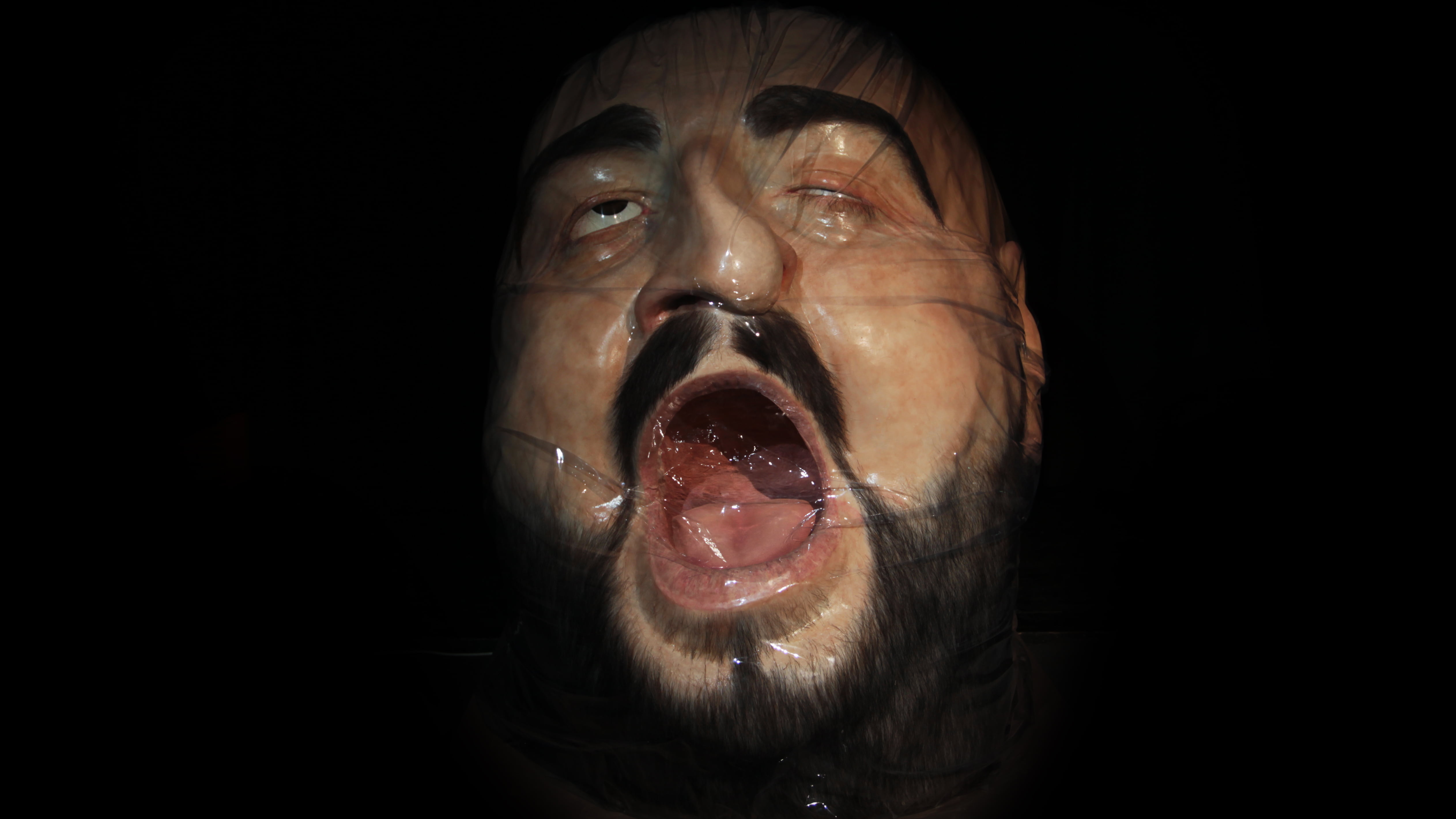Žarko Bašeski’s latest work Asphyxia (sculpture; silicon, nylon, natural hair; 200 x 180 x 160 cm), is a powerful symbol of man’s existential condition in the modern world.
This work can be understood as a desperate cry of the mankind, dying in a suicidal agony. This agony is represented by a man’s bizarre suicide attempt.
What we see is a terror-stricken, suffocating face of a man’s head, fighting for breath in a transparent plastic bag, while images of beautiful and pleasant memories of his life run inside his mind (by way of a video projection). The artist has created this sculpture simulating human flesh and skin by using silicon, artificial paints and hairs, so as to highlight man’s intrinsic carnal character, his physical presence in the world, amidst the emptiness, the void, in which only images of memories float. The projection of this deluge of recollections at the moment of death emphasizes the presence of death in this work even more.
The silent scream of the suffocating man accuses. The world we live in today is polluted, dirtied, full of waste and garbage. It is a world of total destruction of nature, of industrial waste polluting mountains and seas; a world where man has been degraded and replaced by machines; where he feels deficient and degenerate; a world that does not belong to him anymore, a horrible world devastated by forces he no longer controls; a world of war conflicts, political manipulations, deceptions and lies. It is a world in which man cannot exist and the only thing for him to do is to struggle for yet another gasp before the unstoppable machine of death.
The transparent plastic bag over the head of the man belongs to the readily recognized symbols of modern times. The indestructible plastic bag is ubiquitous. Billions of plastic bags pile up into hills and mountains that change earth’s relief; plastic bags float on the surface of seas, get carried by rivers and blown by winds across fields, hang on branches of trees, roll down streets, fly in the air, suffocate cities…
Bašeski’s work, this gigantic head in a plastic bag and the face with open mouth in the existential vacuum is a terrifying evidence and fierce protest against the conditions in this world where man is suffocating; a world he cannot escape; a world transformed into a dumping ground over whose toxic fumes cities flicker like ghostly apparitions.
This impressive work is at the same time a symbol of a world where Eros (the life instinct) is subordinated to Thanatos (the death instinct). It is a world where death rules. It is a symbol of a world where there is no protest because protest is impossible; there is no drive because heroism is futile; there is only physics and no metaphysics; sexuality is replaced by transsexuality; apotheosis becomes impossible and only asphyxia remains.
This man’s face, its spasm, the plastic bag over his head, his open mouth and silent scream can also be recognized as a pervert satisfaction brought to extreme; getting pleasure by facing death. Pleasure is possible only in the presence of death.
Auto-erotic asphyxia is intentional limitation of oxygen flow into the brain in order to increase sexual pleasure. It is performed by the suffocating person themself. It is this seeming or simulated death when facing one’s own end or finality; the powerful shock of this encounter between our body and the reality of our transience; the reality of our fleeting life on the border between existence and non-existence – that strongly emphasizes a moment when the body is still enjoying its functions which are brought to a climax and ecstasy, before it finally falls into the hands of death.
In this world in which we are stranded, sex and crime are the only things left to the mortals (Marquis de Sade) to acknowledge their existence against the horror of finality, against the relentless nature and empty skies that Gods have abandoned a long time ago.
In this work by Bašeski, the sigh of passion is equal to the sigh of death. The facial spasm, the expression of pain which is not different from the expression of satisfaction, points to the edge, to the borderline where pain transforms into pleasure, where death is a confirmation of life. Death causes erection and this very edge, this borderline, the point where something shifts into its opposite, is the place where modern man finds himself in the world today.
Asphyxia sets a state of perpetual returning; real death is no longer possible, there is only fascination with the illusion of constant coming back to life and pleasure. It is a world where life is lived to the last breath, there is no past or future, no comfort, redemption or satisfaction; it is a world where only sensuality is present; instead of structure, there is only absurd existence.
If we make an effort to hear what the suffocating man behind the foil says, it will probably be – I’m dying. It is not just a metaphor (metonymy) of ultimate ecstasy but its substitute: to experience orgasm is to die. Orgasm is a little death (Le petite mort). Death acknowledges life. Joy of life exists only because of the grip of death.
At the end, there is only a cry, regardless of the fact whether we are calling death in the ecstasy of pleasure, committing suicide or as victims of violence. This is the reason why Bašeski sculpture can be reduced to a single idea: human existence today defeats the idea of any meaning of human existence.
Emil Aleksiev
